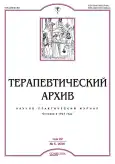Frequency of sarcopenia and factors associated with lean mass in women with rheumatoid arthritis
- Authors: Toroptsova N.V.1, Dobrovolskaya O.V.1, Nikitinskaya O.A.1, Demin N.V.1, Feklistov A.Y.1
-
Affiliations:
- Nasonova Research Institute of Rheumatology
- Issue: Vol 92, No 5 (2020)
- Pages: 15-21
- Section: Original articles
- URL: https://journals.rcsi.science/0040-3660/article/view/34521
- DOI: https://doi.org/10.26442/00403660.2020.05.000622
- ID: 34521
Cite item
Full Text
Abstract
Aim. To evaluate the frequency of sarcopenia (SP) according to EWGSOP2 criteria and factors associated with low lean mass in women with rheumatoid arthritis (RA).
Materials and methods. 79 women (aged 40–75 years) with RA were enrolled in the study. We analyzed clinical data: age, body mass index (BMI), disease duration, methotrexate use, glucocorticoid use, anthropometric measurements, C-reactive protein level, disease activity score in 28 joints-erythrocyte sedimentation rate, bone mineral density (BMD) of the lumbar spine, femur neck, total hip and body composition by Dual energy X-ray absorptiometry. Also, muscle strength and functional tests were performed. We analyzed the correlation between disease parameters and low lean mass with the Spearman method.
Results. 73 (92%) patients had low muscle strength, 20 (25%) patients had low muscle strength and low lean mass, among them 9 (11%) – also had functional disability. There was no correlation between the age of patients and the presence of SP, while the duration of RA in women with SP was significantly greater (p=0.006). There were significant correlations between lean mass and body mass index, glucocorticoids used, methotrexate doses, creatinine and urea acid serum concentration, bone mineral density and falls number.
Conclusion. According EWGSOP2 confirmed sarcopenia was found in 25% RA patients, among them 11% women had severe sarcopenia. Lean mass correlated with the factors related to the disease itself and some general clinical parameters, which requires further study.
Full Text
##article.viewOnOriginalSite##About the authors
N. V. Toroptsova
Nasonova Research Institute of Rheumatology
Email: olgavdobr@mail.ru
ORCID iD: 0000-0003-4739-4302
д.м.н., зав. лаб. остеопороза
Russian Federation, MoscowO. V. Dobrovolskaya
Nasonova Research Institute of Rheumatology
Author for correspondence.
Email: olgavdobr@mail.ru
ORCID iD: 0000-0002-2809-0197
к.м.н., науч. сотр. лаб. остеопороза
Russian Federation, MoscowO. A. Nikitinskaya
Nasonova Research Institute of Rheumatology
Email: olgavdobr@mail.ru
ORCID iD: 0000-0001-6759-8367
к.м.н., ст. науч. сотр. лаб. остеопороза
Russian Federation, MoscowN. V. Demin
Nasonova Research Institute of Rheumatology
Email: olgavdobr@mail.ru
ORCID iD: 0000-0003-0961-9785
мл. науч. сотр. лаб. остеопороза
Russian Federation, MoscowA. Yu. Feklistov
Nasonova Research Institute of Rheumatology
Email: olgavdobr@mail.ru
ORCID iD: 0000-0002-7661-3124
мл. науч. сотр. лаб. остеопороза
Russian Federation, MoscowReferences
- Общая заболеваемость взрослого населения России в 2017 году. Статистические материалы. Министерство здравоохранения Российской Федерации, Департамент мониторинга, анализа и стратегического развития здравоохранения. ФГБУ «Центральный научно-исследовательский институт организации и информатизации здравоохранения» Минздрава России. Сборник. М., 2018; с. 127 [The total incidence of the adult population of Russia in 2017. Statistical materials. Ministry of Health of the Russian Federation Department of Monitoring, Analysis and Strategic Development of Health Care. Central Research Institute of Organization and Informatization of Health of the Ministry of Health of Russia. Collection. Moscow, 2018; p. 127 (In Russ.)]. https://www.rosminzdrav.ru/ministry/61/22/stranitsa-979/statisticheskie-i-informatsionnye-materialy/statisticheskiy-sbornik-2017-god
- Никитинская О.А., Торопцова Н.В., Демин Н.В. и др. Риск остеопоротических переломов у больных ревматоидным артритом: результаты программы «Остеоскрининг Россия». Научно-практическая ревматология. 2018;56(3):310-5 [Nikitinskaya OA, Toroptso- va NV, Demin NV, et al. The risk of osteoporotic fractures in patients with rheumatoid arthritis: results of the program «Osteoscreening Russia». Nauchno-Prakticheskaya Revmatologiya (Rheumatology Science and Practice). 2018;56(3):310-5 (In Russ.)]. doi: 10.14412/1995-4484-2018-310-315
- Rosenberg I. Summary comments. Am J Clin Nutr. 1989;50:1231-3. doi: 10.1093/ajcn/50.5.1231
- Cruz-Jentoft AJ, Bahat G, Bauer J, et al. Writing Group for the European Working Group on Sarcopenia in Older People 2 (EWGSOP2), and the Extended Group for EWGSOP2. Sarcopenia: revised European consensus on definition and diagnosis. Age Ageing. 2019;48(1):16-31. doi: 10.1093/ageing/afy169
- Díaz BB, González DA, Gannar F, et al. Myokines, physical activity, insulin resistance and autoimmune diseases. Immunology Letters. 2018;203:1-5. doi: 10.1016/j.imlet.2018.09.002
- Alkan Melikoğlu M. Presarcopenia and its Impact on Disability in Female Patients With Rheumatoid Arthritis. Arch Rheumatol. 2017;32(1):53-9. doi: 10.5606/ArchRheumatol.2017.6078
- Barone M, Viggiani MT, Anelli MG, et al. Sarcopenia in Patients with Rheumatic Diseases: Prevalence and Associated Risk Factors. J Clin Med. 2018;7(12):504. doi: 10.3390/jcm7120504
- Matheï C, Pottelbergh GV, Vaes B, et al. No relation between vitamin D status and physical performance in the oldest old: Results from the Belfrail study. Age Ageing. 2013;42(2):186-90. doi: 10.1093/ageing/afs186
- Мясоедова С.Е., Рубцова О.А., Мясоедова Е.Е. Композиционный состав тела и минеральная плотность кости у женщин при ревматоидном артрите. Клиницист. 2016;10(3):41-5 [Myasoedova SE, Rubtsova ОА, Myasoedova ЕЕ. Body composition and bone mineral density in women with rheumatoid arthritis. Clinician. 2016;10(3):41-5 (In Russ.)]. doi: 10.17650/1818-8338-2016-10-3-41-45
- Tournadre A, Pereira B, Dutheil F, et al. Changes in body composition and metabolic profile during interleukin 6 inhibition in rheumatoid arthritis. J Cachexia, Sarcopenia Muscle. 2017;8(4):639-46. doi: 10.1002/jcsm.12189
- Ngeuleu A, Allali F, Medrare L, et al. Sarcopenia in rheumatoid arthritis: prevalence, influence of disease activity and associated factors. Rheumatol Int. 2017;37(6):1015-20. doi: 10.1007/s00296-017-3665-x
- Torii M, Hashimoto M, Hanai A, et al. Prevalence and factors associated with sarcopenia in patients with rheumatoid arthritis. Modern Rheumatol. 2018;29(4):589-95. doi: 10.1080/14397595.2018.1510565
- Oliveros E, Somers VK, Sochor O, et al. The concept of normal weight obesity. Progress Cardiovasc Dis. 2014;56:426-33. doi: 10.1016/j.pcad.2013.10.003
- Vlietstra L, Stebbings S, Meredith-Jones K, et al. Sarcopenia in osteoarthritis and rheumatoid arthritis: The association with self-reported fatigue, physical function and obesity. PLoS ONE. 2019;14(6):e0217462. doi: 10.1371/journal.pone.0217462
- Mochizuki T, Yano K, Ikari K, Okazaki K. Sarcopenia-associated factors in Japanese patients with rheumatoid arthritis: A cross-sectional study. Geriatr Gerontol Int. 2019;19(9):907-12. doi: 10.1111/ ggi.13747
- Lin JZ, Liang JJ, Ma JD, et al. Myopenia is associated with joint damage in rheumatoid arthritis: a cross-sectional study. J Cachexia, Sarcopenia Muscle. 2019;10:355-67. doi: 10.1002/jcsm.12381
- Müller R, Kull M, Põlluste K, et al. Factors Associated with Low Lean Mass in Early Rheumatoid Arthritis: A Cross-Sectional Study. Medicina. 2019;55:730. doi: 10.3390/medicina55110730
Supplementary files







